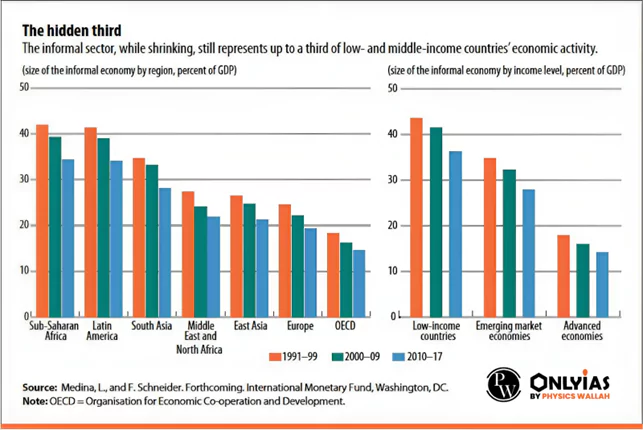By Dr. Gyan Pathak
Informal employment in the total employment in India remains almost stagnant at around 90 per cent since 2014, according to a latest ILO report. It was worse in 2024 than the global average of 58 per cent, Asia Pacific average of 66 per cent, and worse than neighbouring countries like Pakistan, Bangladesh, and Sri Lanka.
The ILO report titled “Innovative approaches to formalization in Asia and the Pacific” shows informality in India at 88.8 per cent, in Pakistan 84.3 per cent, in Bangladesh 84.9 per cent, and in Sri Lanka 67 per cent.
Though the report mentioned many Indian schemes to improve schemes for formalization of employment in India while praising them as innovative approaches, but said nothing about the failures of the schemes in significantly reducing informality in the last one decade. For example, the Employment Linked Incentive (ELI) scheme was praised by the report but it does not mention that the budget year 2024-25 was just lost without even launch of this scheme.
If we go through the India’s innovative approaches mentioned in the ILO report to formalization of employment or creation of decent jobs, it reads well, but informal employment remaining at about 90 per cent is clear indication that India’s strategy for formalization of jobs or creation of formal jobs have failed, a fact which ILO report avoided to put on record in clear terms.
Nevertheless, the report read, “In terms of the overall global distribution of informality, the majority – nearly two thirds – of workers in the informal economy are in Asia and the Pacific. This is due in part to the size of the population of the region, notably in China and India, and persistently high levels of informality. In fact, while there has been progress in reducing the incidence of informality over the past two decades, which has fallen from nearly 73 per cent of total employment in 2004 to just under 66 per cent in 2024, the rate of progress has slowed considerably since the onset of the COVID-19 pandemic. As a result, the incidence of informality in the region remains second only to Africa (83 per cent) and nearly 8 percentage points higher than the global average (58 per cent).”
Within the region, there is noticeable variation in the incidence of informal employment, ranging from nearly 87 per cent in Southern Asia to as low as 35 per cent in the Pacific Islands (East Asia is also considerably low, at around 27 per cent if China is excluded). In terms of patterns over the past two decades, like the region overall, gains in the Pacific Islands have been slow and are relatively unchanged in the past five years.
In contrast, in Southern Asia where rates are already elevated, there has been an increase in the overall share of informal employment in total employment in the past decade. Whereas South-Eastern Asia and Eastern Asia – pandemic increases aside – have seen significant and steady improvements since 2004.
A number of sub regional trends merit highlighting. First, the share of informal employment in Southern Asia is as high as what is found in Sub-Saharan Africa (89.2 per cent). Second, within Asia and the Pacific, Eastern Asia and South-Eastern Asia experienced the most significant decreases in the share of informal employment over the last two decades, with both subregions seeing declines of nearly 14 percentage points (significantly more the region as a whole).
Underlying these, the report mentions country specific variations and says that the rate of informality remains close to 90 per cent or more in India and the Lao People’s Democratic Republic. By contrast, a number of countries from South-Eastern Asia experienced a significant decline in the share of informal employment. For instance, there has been approximately a 10 percentage point decrease in the rate of informality in Thailand and Viet Nam over the past decade. While in Mongolia (East Asia), a decrease of nearly 8 percentage points in the share of informality was achieved between 2010 and 2022.
The informal economy presents significant challenges to workers’ rights, social protection, decent working conditions and inclusive economic growth. Globally, over two billion people work informally, with the Asia and Pacific region accounting for nearly two-thirds of this total, the report emphasized. The persistence of informality undermines sustainable enterprises, hinders access to labour rights and social protection, erodes public revenues and exacerbates inequality and poverty.
Informality is persisting despite the ILO’s recommendation adopted in 2015, which provides guidelines for transitioning from informal to formal economy. Nevertheless, the ILO report says that Asia-Pacific region has made some progress, about 7 per cent decline in informality in the last two decades to 66 per cent. However, this decline has been offset by the overall growth in the total number of workers, leading to an increase in the absolute number of informal workers.
Part of the challenge in the region is the notable absence of dedicated and integrated approaches that acknowledge the complex interrelations and synergies required to effectively and persistently tackle informality. Currently, tripartite structures engaged in the governance and coordination of formalization efforts are largely lacking across the region, with only a few notable exceptions. Large segments of the workforce are trapped in low-productivity sectors. Efforts to reduce informality are most effective when focus is on increasing incomes and improving working conditions, which strongly influence workers’ capacity to move between the informal and formal economies, and hence, the report says, more efforts are needed. (IPA Service)




 Supreme Court Produces A Please-All Interim Pause On Waqf Amendments Law
Supreme Court Produces A Please-All Interim Pause On Waqf Amendments Law 